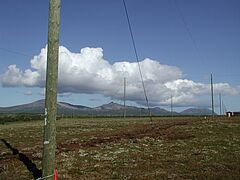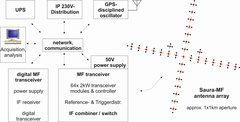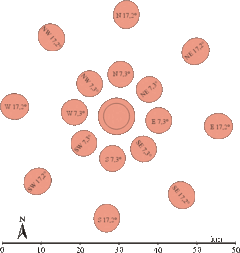A new narrow beam MF radar has been installed in July 2002 close to the Andoya Space Center and the ALOMAR observatory to improve the ground based capabilities for studies of the dynamical status (small scale features, turbulence) of the upper mesosphere. The characteristics of radio wave scatterers can be studied now in a wider frequency range by common volume observations with the MAARSY VHF radar at 53.5 MHz.
The radar has been developed by Atmospheric Radar Systems (ATRAD). The main feature of the new radar is the antenna which is formed by 29 crossed half-wave dipoles arranged as a Mills-Cross. The spacing of the crossed dipoles is 0.7 wave lengths resulting in a minimum beam width of 6°. This antenna system allows observations of a comparably small volume.
Each dipole is fed by its own transceiver unit with a peak power of 2 kW (phase controlled on transmission and reception) providing high flexibility in beam forming and pointing as well as o- and x-mode operation for differential absorption and phase measurements. For example, off-zenith beams towards NW, NE, SE, SW at 6.8° or 13.6° can be formed. The figure below shows the areas at 85 km altitude illuminated by the vertical and various oblique beams. In addition, beams with different widths at the same pointing angle can be formed. For multiple receiver applications four independent receiving channels and two additional crossed dipole antennas are available.
Technical Parameters
| Frequency | 3,17 MHz |
| Peak power | 116 kW |
| Pulse width | 7, 10, 13.3 µs |
| 3dB Beamwidth | 6.4° |
| Height range | 50-94 km |
| Height resolution | 1-1.5 km |
| Sampling resolution | 1 km |
| Receiver channel | 9 digital |
| Pulse coding | none, 4 bit |
The system working at 3.17 MHz was put into operation in July 2002 applying spaced antenna observations and reached its full Doppler capabilities in April 2003.
Beside wind observations it is possible to derive with the Saura-MF-Radar also turbulence parameters from the spectral width of the radar echoes as due to the small radar beam the disturbing influence of the horizontal wind can easily be eliminated. Also from the calibrated echo power information about the atmospheric turbulence can be derived.
Due to an alternating operation of the MF-Saura-Radar with different polarisations (o- and x-mode) it is possible to derive electron densities between about 65 and 85 km by differential absorption and phase measurements.
















